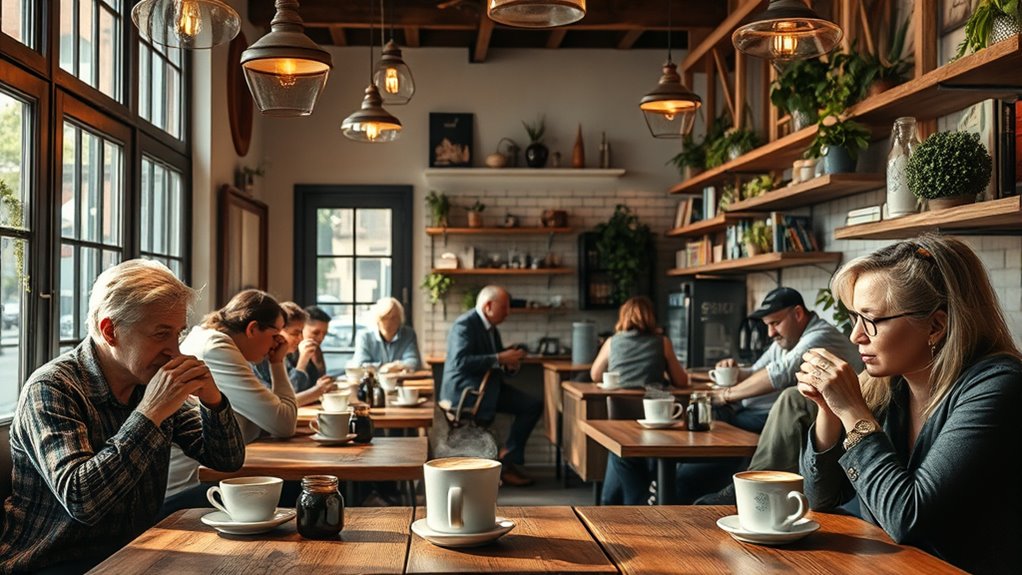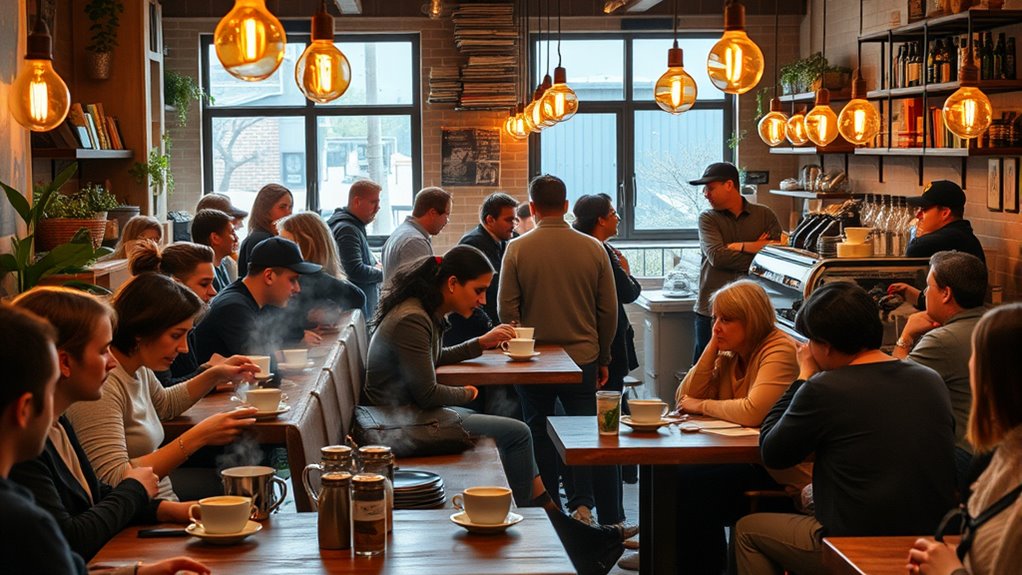You love coffeehouses because they’re more than just places to grab a drink; they’re social hubs that foster connection and creativity. From their origins as gathering spots for merchants and scholars to modern spaces for friends and colleagues, cafés reflect cultural identities and encourage face-to-face interactions. They break down social barriers and build community, helping us feel connected in a busy world. To discover how these timeless spaces continue to shape society, keep exploring their fascinating story.
Key Takeaways
- Coffeehouses have a rich history as social and intellectual hubs, fostering community and cultural exchange.
- They serve as welcoming spaces for face-to-face interactions, strengthening social bonds and inclusivity.
- Café culture offers a unique ambiance that celebrates local traditions and enhances cultural identity.
- The evolving role of coffeehouses reflects society’s adaptability, maintaining relevance across generations and social groups.
- They act as crossroads for ideas, creativity, and diverse backgrounds, enriching the social fabric.

Café culture has become an essential part of social life around the world, offering more than just a place to grab a coffee. It’s a space where history, evolution, and social interactions intertwine, creating a vibrant environment that reflects changing societies over centuries. From the bustling streets of Paris to modern coffee chains worldwide, cafés have served as hubs of community, conversation, and cultural exchange. You might not realize it, but stepping into a café connects you to a long-standing tradition that dates back centuries. Originally, cafés emerged in the Middle East and Ottoman Empire, where they quickly became gathering spots for merchants, scholars, and artists. Over time, their role evolved, especially during the European Enlightenment, when cafés became intellectual salons. These venues fostered lively debates, inspired new ideas, and provided a space for social interaction outside traditional settings. As the centuries progressed, cafés adapted to societal shifts, becoming more accessible to different social classes and opening up to diverse groups. This evolution allowed the café to remain relevant as a social anchor, constantly reflecting the needs and values of its community. Your visits to a café today are part of this ongoing story—an extension of a centuries-old tradition of shared space and interaction. The social interactions that happen within these walls continue to shape communities, whether through casual conversations, business meetings, or creative collaborations. Coffeehouses have historically served as melting pots, bringing together people from various backgrounds, fostering dialogue, and breaking down social barriers. They’re more than just places to caffeinate; they’re settings where ideas are exchanged, friendships are formed, and cultures are celebrated. The evolution of café culture highlights its adaptability and importance in fostering social cohesion. Even in the digital age, cafés still serve as essential communal spaces, offering an environment that encourages face-to-face contact in a world increasingly dominated by screens. When you sit down for a coffee, you’re participating in a tradition that has shaped social interactions for generations. You’re part of a larger story—one where the café acts as a crossroads of history, culture, and community. cultural identity is often expressed and reinforced through the unique ambiance and customs of each café, further enriching the social fabric they help weave. Additionally, the ongoing **social interactions** within cafés are vital for building community and emotional resilience in modern society.
Frequently Asked Questions
How Did Café Culture Originate Historically?
You might wonder how café culture began. The coffeehouse origins trace back to 15th-century Middle Eastern societies, spreading through Europe in the 17th century. As you explore the historical development, you’ll see these spaces became hubs for conversation, ideas, and social change. Coffeehouses evolved from simple gathering spots into influential centers of culture and intellectual exchange, shaping modern social life and fostering a sense of community.
What Are the Unique Features of Modern Coffeehouses?
You’ll notice modern coffeehouses embrace specialty brewing, creating rich flavors and unique experiences. They foster cozy atmospheres, inviting you to relax or focus. These spaces often feature contemporary decor, free Wi-Fi, and community events, blending tradition with innovation. Whether you’re working, socializing, or unwinding, today’s coffeehouses cater to diverse needs, making each visit a personalized experience through specialty brewing and cozy atmospheres.
How Do Cafés Influence Local Communities?
Cafés influence local communities by fostering community engagement and strengthening social cohesion. When you visit a café, you create opportunities for neighbors to connect, share ideas, and build relationships. These venues become gathering spots that support local culture and encourage collaboration. By bringing people together in a relaxed setting, cafés help develop a sense of belonging and shared identity, making the community more vibrant and resilient.
What Are Common Etiquette Practices in Coffeehouses?
Imagine entering a cozy café where everyone respects ordering etiquette and table manners. You should calmly place your order, speak kindly to staff, and keep your voice low. Avoid interrupting others, and don’t forget to clear your table when finished. Just like a well-orchestrated symphony, good etiquette guarantees everyone enjoys their experience. Following these simple practices creates a welcoming environment where coffee lovers can connect and relax.
How Has Technology Impacted Contemporary Café Experiences?
You’ve probably noticed that technology now shapes your café visits through digital ambiance, creating immersive atmospheres with mood lighting and virtual backgrounds. Virtual baristas, powered by AI, help you place orders quickly and personalize your experience. These innovations make your café experience more seamless and engaging, blending the comfort of a traditional coffeehouse with modern digital convenience, making each visit uniquely tailored to your preferences.
Conclusion
Stepping into a coffeehouse is like entering a warm, inviting garden where ideas bloom and connections grow. You find yourself surrounded by the aroma of fresh brew and the hum of conversations, each sip fueling creativity and comfort. Café culture isn’t just about coffee; it’s a vibrant tapestry of community, inspiration, and shared moments. Embrace these spaces, and you’ll see how they transform simple routines into a rich, living mosaic of human connection.









